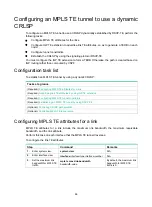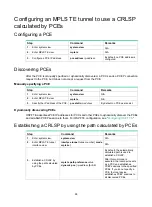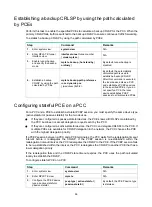
93
Step Command
Remarks
1.
Enter system view.
system-view
N/A
2.
Enter MPLS TE tunnel
interface view.
interface tunnel
tunnel-number
[
mode
mpls-te
]
N/A
3.
Record routes or record
both routes and labels.
•
To record routes:
mpls te record-route
•
To record both routes and labels:
mpls te record-route label
By default, both route
recording and label
recording are disabled.
Enabling loop detection
Enabling loop detection also enables the route recording feature, regardless of whether you have
configured the
mpls te record-route
command. Loop detection enables each node of the tunnel to
detect whether a loop has occurred according to the recorded route information.
To enable loop detection:
Step Command
Remarks
1.
Enter system view.
system-view
N/A
2.
Enter MPLS TE tunnel
interface view.
interface tunnel
tunnel-number
[
mode
mpls-te
]
N/A
3.
Enable loop detection.
mpls te loop-detection
By default, loop detection is
disabled.
Setting tunnel setup retry
If the ingress node fails to establish an MPLS TE tunnel, it waits for the retry interval, and then tries to
set up the tunnel again. It repeats this process until the tunnel is established or until the number of
attempts reaches the maximum. If the tunnel cannot be established when the number of attempts
reaches the maximum, the ingress waits for a longer period and then repeats the previous process.
To set tunnel setup retry:
Step Command
Remarks
1.
Enter system view.
system-view
N/A
2.
Enter MPLS TE tunnel
interface view.
interface tunnel
tunnel-number
[
mode
mpls-te
]
N/A
3.
Set the maximum number of
tunnel setup attempts.
mpls te retry
retries
By default, the maximum number
of attempts is 3.
4.
Set the retry interval.
mpls te timer retry
seconds
By default, the retry interval is 2
seconds.
Configuring automatic bandwidth adjustment
Step Command
Remarks
1.
Enter system view.
system-view
N/A
2.
Enter MPLS TE view.
mpls te
N/A
















































